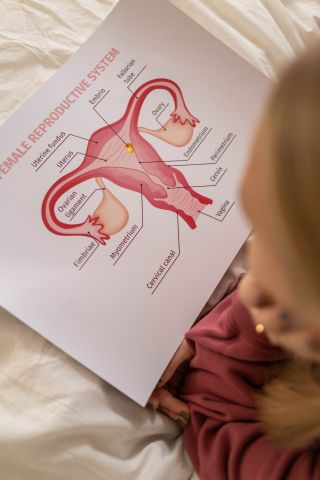Hormones
Polycystic Ovary Syndrome and Eating Disorders
Encouraging people with PCOS to lose weight could push them to binge eat.
Posted April 21, 2023 Reviewed by Vanessa Lancaster
Key points
- Polycystic ovary syndrome is a common hormonal condition where people assigned females at birth have high testosterone and reduced fertility.
- Binge eating is common in people with polycystic ovary syndrome.
- Polycystic ovary syndrome treatment should include eating disorder prevention.

The female reproductive cycle is regulated by a balance of hormone exchanges between the brain's pituitary gland and the ovaries. The pituitary gland first releases follicle-stimulating hormone (FSH), which stimulates the ovaries to create a follicle or a sac housing a developing egg. This follicle releases estrogen, which stimulates the pituitary gland to release luteinizing hormone (LH). LH is responsible for pushing the developed egg out of the follicle sac and down the fallopian tube for fertilization. The right balance of these hormones is essential for egg development and fertilization.
A condition that disrupts the female reproductive cycle is Polycystic Ovary Syndrome (PCOS).1 PCOS is a common but heterogenous condition where people assigned females at birth have elevated androgen (e.g., testosterone) and LH levels.2;3 These hormonal imbalances prevent eggs from developing and leaving the follicles for fertilization, resulting in a buildup of underdeveloped egg sacs (i.e., ovarian cysts) in the ovaries. In addition to fertility difficulties, PCOS symptoms can include irregular or absent periods, increased body hair, scalp hair loss, weight gain, and acne.
PCOS symptoms vary from person to person, and the causes of PCOS are unclear.2;3 One possible cause for PCOS is insulin resistance, which occurs in roughly 70 percent of people with PCOS.3 Insulin is a hormone that removes extra sugar from the blood by opening up cells. These cells "consume" the sugar and convert it to energy. In the bodies of people with insulin resistance, however, these cells don't open up, which causes sugar to build up in the blood. Excess blood sugar stimulates the pancreas to produce more insulin as a way to force blood sugar into cells. This extra insulin increases androgen (i.e., testosterone) release from the ovaries, which disrupts egg development.
Other potential causes for PCOS include chronic, low-grade inflammation4 and excess LH from the pituitary gland, which can elevate androgen levels.5 PCOS might also be genetic.6
Eating Disorders and Polycystic Ovary Syndrome
Binge eating disorder (BED) is common in people with PCOS.7 BED is defined as uncontrollably eating an atypically large portion of food during a short period of time (e.g., one hour).7 To be considered BED, a person must binge eat for at least one day a week over a three-month period.

The exact prevalence of BED in people with PCOS is unknown. However, a recent research review found that women with PCOS are over three times as likely to have eating disorder symptoms as women without PCOS, and up to 58 percent of women with PCOS binge eat.8 People with PCOS are also susceptible to developing bulimia nervosa (BN), a different binge-type eating disorder that involves purging (i.e., vomiting) behavior.12;13;14
Why binge-type eating disorders are common in people with PCOS is unclear.9;10;11 One possible explanation is high androgen levels, which contribute to appetite increases, anxiety, depression, and body dissatisfaction (i.e., increased body hair, weight gain, and scalp hair loss), all of which contribute to binge eating.8;21 High insulin levels might also explain why many women with PCOS binge eat, as insulin contributes to carbohydrate cravings and increased appetite.8
Both biological (i.e., hormone imbalances) and psychological (i.e., appearance dissatisfaction; distress) factors, therefore, contribute to binge eating in PCOS.
The Challenges of Treating Eating Disorders in People With Polycystic Ovary Syndrome
Despite the frequency of binge-type eating disorders in PCOS, eating disorder prevention during PCOS treatment is rarely discussed.15;16;17 Having these discussions is important, though, as weight loss is commonly recommended to alleviate PCOS symptoms (e.g., androgen levels) and prevent future health complications (e.g., diabetes; cardiovascular disease).15;16;17

Encouraging people with PCOS to lose weight can be dangerous because people with PCOS often find it difficult to lose weight.18;19 Weight loss in PCOS is challenging because insulin resistance can increase hunger and fat storage.18;19 This means that people with PCOS might maintain or gain weight despite intense diet and exercise. The distress of not meeting their weight loss goals might push these individuals to binge eat.
Not reaching a target weight might also push people with PCOS to food restrict, which could lead to the development of anorexia nervosa (AN).20 AN is a disorder of food restriction, fear of weight gain, and low body weight. Unlike PCOS, the primary treatment for AN is weight gain. While individuals with co-occurring PCOS and AN are encouraged to gain weight, they are also recommended not to exceed a certain weight.20 For people with AN, being told to stay under a certain weight can severely hinder their recovery, as weight monitoring encourages calorie counting and fear of weight gain.
How to Treat Individuals With Coexisting Polycystic Ovary Syndrome and an Eating Disorder
There is currently no cure for PCOS. Rather, the goals of PCOS treatment are multifaceted, including alleviating PCOS symptoms (e.g., irregular periods, infertility, and hormonal imbalance), improving patient well-being, and preventing the development of medical complications (e.g., diabetes; cardiovascular disease). Therefore, holistic approaches for PCOS treatment without weight loss should be considered.

A multifaceted approach to PCOS treatment will require experts in nutrition, gynecology, endocrinology, fertility, eating disorders, and cognitive behavioral therapy. A personalized treatment approach is also ideal in PCOS treatment, as PCOS symptoms vary across individuals. Hormonal imbalances in PCOS range from mild to severe, and not all people with PCOS are infertile or seek fertility treatment.2;3 And, while most individuals with PCOS are insulin resistant (i.e., 70 percent), not all are.2;3
A range of pharmaceuticals can be used to alleviate PCOS symptoms. Individuals with high androgen levels are often prescribed a diuretic called spironolactone. Spironolactone lowers androgen levels by preventing extra androgen release in the body.22 Spironolactone also reduces PCOS-related bloating. If people with PCOS are insulin resistant, they might be prescribed metformin. Metformin is a biguanide (i.e., diabetes medication) that prevents the liver from producing too much glucose, reducing the body's insulin levels.23 Some pharmaceuticals can reduce PCOS symptoms such as acne and atypical body hair growth.24
Beyond alleviating PCOS symptoms, individuals with PCOS should have access to psychologists and nutritionists. Because there is currently no cure for PCOS, it is important for individuals with PCOS to learn how to cope with their condition. In counseling, this could mean accepting fertility difficulties or working on body dissatisfaction and disordered eating behavior. Similarly, a nutritionist could help people with PCOS determine which foods aggravate or alleviate their symptoms. The goal of these lifestyle changes, though, should be overall well-being, not weight loss.
To find a therapist, visit the Psychology Today Therapy Directory.
References
1.) Carmina, E., & Lobo, R.A. (1999). Polycystic ovary syndrome (PCOS): Arguably the most common endocrinopathy is associated with significant morbidity in women. The Journal of Clinical Endocrinology & Metabolism, 84, 1897-1899. https://doi.org/10.1210/jcem.84.6.5803.
2.) Balen, A., & Michelmore, K. (2002). What is polycystic ovary syndrome? Are national views important? Human Reproduction, 17, 2219-2227. https://doi.org/10.1093/humrep/17.9.2219.
3.) Diamanti-Kandarakis, E., & Dunaif, A. (2012). Insulin resistance and the polycystic ovary syndrome revisited: An update on mechanisms and implications. Endocrine Reviews, 33, 981-1030. https://doi.org/10.1210/er.2011-1034.
4.) Rudnicka, E., Suchta, K., Grymowicz, M., Calik-Ksepka, A., Smmolarczyk, K., Duszewska, A.,...& Meczekalski, B. (2021). Chronic low grade inflammation in pathogenesis of PCOS. International Journal of Molecular Sciences, 22. https://doi.org/10.3390/ijms22073789.
5.) Malini, N.A., & George, K.R. (2018). Evaluation of different ranges of LH:FSH ratios in polycystic ovarian syndrome (PCOS) - clinical based case control study. General and Comparative Endocrinology, 260, 51-57. https://doi.org/10.1016/j.ygcen.2017.12.007.
6.) Khan, M.J., Ullah, A., & Basit, S. (2019). Genetic basis of polycystic ovary syndrome (PCOS): Current perspectives. The Application of Clinical Genetics, 12, 249-260.
7.) Amianto, F., Ottone, L., Daga, G.A., & Fassino, S. (2015). Binge-eating disorder diagnosis and treatment: A recap in front of DSM-5. BMC Psychiatry, 15.
8.) Krug, I., Giles, S., & Paganini, C. (2019). Binge eating in patients with polycystic ovary syndrome: Prevalence, causes, and management strategies. Neuropsychiatric Disease and Treatment, 15, 1273-1285.
9.) Jeanes, Y.M., Reeves, S., Gibson, E.L., Piggot, C., May, V.A., & Hart, K.H. (2017). Binge eating behaviours and food cravings in women with polycystic ovary syndrome. Appetite, 109, 24-32. https://doi.org/10.1016/j.appet.2016.11.010.
10.) Paganini, C., Peterson, G., Stavropoulos, V., & Krug, I. (2017). The overlap between binge eating behaviors and polycystic ovarian syndrome: An etiological integrative model. Current Pharmaceutical Design, 24, 999-1006.
11.) Lee, I., Cooney, L.G., Saini, S., Smith, M.E., Sammel, M.D., Allison, K.C., & Dokras, A. (2017). Increased risk of disordered eating in polycystic ovary syndrome. Fertility and Sterility, 107, 796-802. https://doi.org/10.1016/j.fertnstert.2016.12.014.
12.) Naessén, S., Carlström, K., Garoff, L., Glant, R., & Hirschberg, A.L. (2006). Polycystic ovary syndrome in bulimic women - an evaluation based on new diagnostic criteria. Gynecological Endocrinology, 22, 388-394.
13.) Jahanfar, S., Eden, A., & Nguyent, T.V. (1995). Bulimia nervosa and polycystic ovary syndrome. Gynecological Endocrinology, 9, 113-117.
14.) McCluskey, S., Evans, C., Lacey, J.H., Pearce, J.M., & Jacobs, H. (1991). Polycystic ovary syndrome and bulimia. Fertility and Sterility, 55, 287-291.
15.) Dokras, A., Sarwer, D.B., Allison, K.C., Milman, L., Kris-Etherton, P.M., Kunselman, A.R.,...& Legro, R.S. (2016). Weight loss and lowering androgens predict improvements in health-related quality of life in women with PCOS. The Journal of Clinical Endocrinology & Metabolism, 101, 2966-2974. https://doi.org/10.1210/jc.2016-1896.
16.) Moran, L.J., Pasquali, R., Teede, H.J., Hoeger, K.M., & Norman, R.J. (2009). Treatment of obesity in polycystic ovary syndrome: A position statement of the androgen excess and polycystic ovary syndrome society. Fertility and Sterility, 92, 1966-1982. doi: 10.1016/j.fertnstert.2008.09.018.
17.) Teede, H.J., Misso, M.L., Deeks, A.A., Moran, L.J., Stuckey, B.G., Wong, J.L.,...& Guideline Development Groups. (2011). Assessment and management of polycystic ovary syndrome: Summary of an evidence-based guideline. The Medical Journal of Australia, 195, S65-112. doi: 10.5694/mja11.10915.
18.) Rodin, J. (1985). Insulin levels, hunger, and food intake: An example of feedback loops in body weight regulation. Health Psychology, 4, 1-24. https://doi.org/10.1037/0278-6133.4.1.1.
19.) Lewis, G.F., Carpentier, A., Adeli, K., & Giacca, A. (2002). Disordered fat storage and mobilization in the pathogenesis of insulin resistance and type 2 diabetes. Endocrine Reviews, 23, 201-229. https://doi.org/10.1210/edrv.23.2.0461.
20.) Pinhas-Hamiel, O., Pilpel, N., Carel, C., & Singer, S. (2006). Clinical and laboratory characteristics of adolescents with both polycystic ovary disease and anorexia nervosa. Fertility and Sterility, 85, 1849-1851. https://doi.org/10.1016/j.fertnstert.2005.11.041.
21.) Morgan, J., Scholtz, S., Lacey, H., & Conway, G. (2008). The prevalence of eating disorders in women with facial hirsutism: An epidemiological cohort study. International Journal of Eating Disorders, 41, 427-431.
22.) Mazza, A., Fruci, B., Guzzi, P., D'Orrico, B., Malaguarnera, R., Veltri, P.,...& Belfiore, A. (2014). In PCOS patients the addition of low-dose spironolactone induces a more marked reduction of clinical and biochemical hyperandrogenism than metformin alone. Nutrition, Metabolism, and Cardiovascular Diseases, 24, 132-139. https://doi.org/10.1016/j.numecd.2013.04.016.
23.) Lord, J.M., Flight, I.H., & Norman, R.J. (2003). Metformin in polycystic ovary syndrome: Systematic review and meta-analysis. BMJ, 327, 1-6.
24.) Badawy, A., & Elnashar, A. (2011). Treatment options for polycystic ovary syndrome. International Journal of Women's Health, 3, 25-35.




